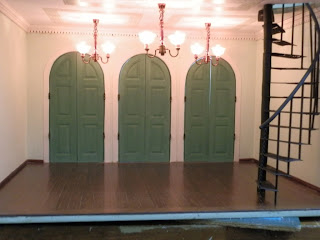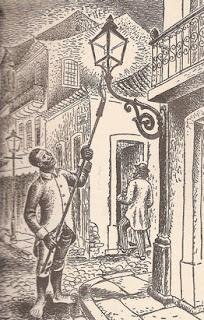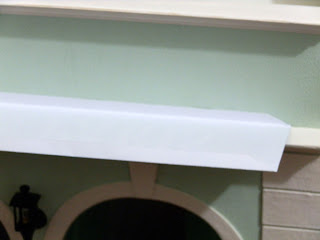Quando estava trabalhando no teto, a idéia de usar um "trompe l'oeil" como moldura para as luminárias pareceu uma boa idéia. Eu até gostei muito das que fiz depois de impressas. Mas... depois de coladas, já nem tanto.
When I was working on the ceiling, the idea of using "Trompe l'oeil" as frame for the chandeliers seemed a good idea. I even liked them after printing. But... after they were glued down, not so much.
E quando postei as fotos da coisa toda pronta, gostei ainda menos! O brilho e o reflexo não estavam nada naturais... Hesitei em consertar o estrago, porque implicaria em um certo trabalho e poderia dar muito errado. Mas quanto mais olhava as fotos (e o próprio teto aqui), menos eu gostava e mais me incomodava!
And when I posted the pictures of the finished thing, I liked them even less! The shine and reflection on the paper I used were not natural at all... I was reluctant to fix that, because it would mean a lot of trouble and the result might be a total disaster... But the more I looked at the pictures (and the ceiling itself), the less I liked it and the more it bothered me!
É claro que o ideal seria colocar um produto já pronto, feito para isso mesmo. O problema é que tem que ser importado e eu não estava nem um pouco a fim de esperar 2 a 3 semanas pelo envio internacional e muito menos pagar R$30 reais pelo frete (odeio os novos preços!) Então coloquei a cachola para funcionar e pensei em algo que poderia dar certo... Eu já tinha um pedaço de papel de parede em relevo, que consegui de uma loja no Canadá já há algum tempo. Como é antiga, já não está tão branquinha assim, mas eu gosto mesmo dela!
Of course the ideal "fix" would be to place ready-made trims, like this one, but no way was I willing to wait 2 to 3 weeks for international delivery and spend $15 on shipping! (I hate the new shipping rates!) So, I put on my thinking cap and thought of something that could work... I had this large piece of real life wallpaper, with texture. I got it some time ago from John Constable, who used to have a miniatures store in Canada and he and his wife are selling everything to retire. It seems old/vintage, the white is not that white anymore, but I like it a lot!
 |
| um acabamento importado a ready-made trim |
Então cortei várias tiras na largura da moldura que já tinha aplicado. Cortei os ângulos em 45º para formar as molduras.
So, I cut some strips to match the width of the trompe l'oeil frames I had installed. I mitered the corners of each strip.
Usei pequenos pedaços de papel comum para colar os cantos por baixo. O papel de parede já vem com cola, mas como é antigo, preferi não confiar muito. Vai que descola com o tempo... No pior das hipóteses, a cola já existente irá ajudar a cola nova a ficar bem colada, hehe...
Then I used a small square of regular paper to glue the corners to form the frame. I know wallpaper has glue on its back, but as it's been around for a while, I decided not to trust the existing glue. I don't know how long it would remain stuck... Worst case scenario, the pre-existing glue would add 'stickiness' to the new one, lol...
Eis a nova moldura pronta...
And here is the new frame...
Prendi todas em um papel (usando pedacinhos de fita adesiva dupla face) para pintar...
I taped them to some scrap paper (using small pieces of double-sided tape) to paint...
E pintei usando uma mistura de cola branca e tinta branca. Tive receio que só a tinta não iria aderir bem à superfície de vinil por muito tempo, e descascaria assim que fosse manipular para colar. Melhor previnir que remediar! :) Também apliquei mais uma camada de tinta branca sozinha e outra de verniz fosco para uma proteção extra.
And painted using a mix of white glue and white paint. I was afraid that paint alone wouldn't stick to the vinyl surface too long and would begin to peel off as soon as I started handling them. Better safe than sorry! :) I also applied another coat of paint alone and, on top of that, a coat of matte water based varnish, for extra protection.
Aqui estão as duas, lado a lado: à esqeurda, a tira pintada, e à direita, o papel original.
And here is the wallpaper, side by side: on the left, the treated strip, on the right, the original sheet.
Aí virei toda a roombox de cabeça para baixo. Ainda bem que ainda não tinha começado a trabalhar no telhado!!! :) A cor do papel base parecia agora branco demais para a nova moldura, e também para as molduras nas paredes. Então apliquei uma demão da mesma tinta nele. Obviamente o papel enrugou aqui e acolá. Só consegui capturar essas ondulações com a câmera na área sombreada...
Then I turned the whole structure upside down. Good thing I hadn't started on the roof yet!!! :) The previous paper color seemed too white for the new frame and also for the mouldings on the side walls. So I applied a coat of the same paint on it. The paper, obviously, created some waves (rippled) here & there. The only way I could capture those on camera was in the shadows...
A solução para este problema é até simples, mas precisa ser aplicada com cuidado: use um ferro de passar de viagem (porque é menor), na menor temperatura possível (não pode ser quente demais ou derreterá a espuma do foamboard), e usando uma ou duas folhas de papel-toalha para proteger tanto o ferro quanto a pintura ou papel embaixo, gentilmente passe o ferro por toda a superfície ondulada. Não pressione o ferro. Com o papel ainda morninho, dê umas batidinhas com o dedo nas ondulações para coagir o papel a voltar para o lugar certo.
The solution for that is simple, but must be applied carefully: Use a travel iron (because it's smaller), on the first marker of heat (it can't be too hot or it'll melt the foam beneath and/or scorch the paper), and using one or two sheets of paper towel to protect both the iron base and the painted surface or the paper, gently iron the waves down. Do not apply pressure. Tap the little "waves" with your finger while still warm to coax them back in place, if needed.
Eis a mesma área novamente, sem ondulações! :)
And here is the same area again, waves gone! :)
E aqui estão o antes e o depois. Não ficou perfeito, eu sei. Mas ficou mais realista do que estava, para mim...
And this is a comparison of the before and after. It's not perfect, I know, but it seems more realistic to me than before...

















































